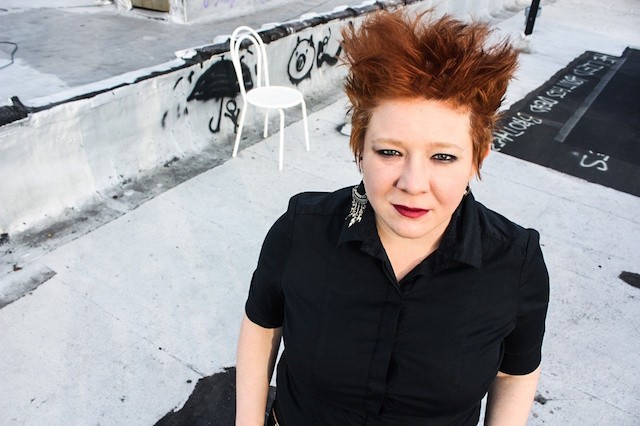Ask southern Illinois native Chavisa Woods where her startling plots and characters come from, and the short answer is her imagination. But as weird and wrenching and "out there" as they may seem, her stories also scream real-life Midwest.
Restless adolescents befriend a strange woman living in a cemetery. A fervent young Southern Baptist burns a birthday present believed to be an occult toy. Casual conversation over cigarettes turns to talk of manslaughter, and a lesbian couple tries to keep it together at a Mensa party immediately after dropping acid.
With eight tales of such people comprising her newest book, Things to Do When You're Goth in the Country (Seven Stories Press, 2017), Woods brings an often invisible landscape into rare focus. It's a book that feels especially resonant given the current cultural moment in America. While it's a work of fiction, and one that even ventures into fantasy, the people at its center are the working class and the rural poor. Often dismissed or even despised, they're shown here in their full complexity over the course of 221 vivid pages.
"I do hope [readers] get a sense of what it feels like to be there," says Woods, 35, who grew up in rural Sandoval, Illinois, and moved to St. Louis as a young adult. "Sexism, racism and bigotry are driving forces in these areas for the actions of the people, and there is also a larger structure driving that" — namely, a capitalist system that offers, she says, "very little chance of any serious class climbing."
One of the stories captures an apocalyptic outlook that seems equal parts hope and despair. "What's Happening on the News?" opens with a twenty-year-old Desert Storm soldier visiting his mother's fourth-grade class with a helmet full of sand from Iraq for show and tell. A child in the room — the narrator of the piece — raises her hand when the hero visitor mentions that a secret $1 million bounty has been placed on Saddam Hussein's head.
"I wanted to know if Saddam Hussein's head should be delivered on a platter or a stick," she explains in the story. "I was a child familiar with the Bible. In biblical stories, heads are often delivered on platters, and sometimes left as warnings on sticks."
For Woods, military recruitment in the U.S. and evangelical Christianity are inextricably linked, and "What's Happening on the News?" reflects that overlap and some of the beliefs she herself espoused as a child, like the connection between Israel, the Dome of the Rock and the second coming of Jesus.
[image-1-"And the adults around me who believed these things were in many ways good, loving people, and gave me a good childhood and cared for me as well as any parent could," Woods says. "But of course, this aspect of my upbringing was notable and is still very strange to me, and when I write about these beliefs and certain experiences, just solely focusing on these religious superstitions, it sounds really absurd and insane."
Talking about it from a child's perspective allows her to present the piece matter-of-factly, without much filter.
"I hope that even though it is a child talking, it's not lost that these beliefs really do impact our national politics and American culture in a huge way," she adds.
Based in Brooklyn these days (she moved to New York in 2003), Woods aims to provide a sense of place and the rhythm of life in her fiction, which now includes three full-length works. She also hopes that those from the areas she writes about "see themselves or people they know represented in a meaningful way."
Along with southern Illinois, St. Louis is a location that keeps cropping up in Woods' work. Many chapters of her 2013 novel, The Albino Album, take place in the city, as does one of the stories in Things to Do When You're Goth in the Country. It's a place the author considers both bizarre and vibrant, and she's looking forward to a return visit this month when she discusses and signs copies of her new book at 7 p.m. June 14 at Left Bank Books.
"Around fifteen years old, I began going to St. Louis on the weekends and spent many days at a time there in the summers because they had a punk scene and a gay youth group and an arts scene," says Woods. She also spent a lot of time in Soulard and at MoKaBe's Coffeehouse, which remains her first stop on trips back to the city.
At eighteen, she moved here. A member of the St. Louis Poetry Slam team for two years, Woods performed in Shakespeare plays at the Grandel Theatre and became active in the area's thriving arts community. Woods was also an early resident of C.A.M.P., a south city anarchist collective still in existence today.
Even then she was already seriously pursuing writing, choosing to work part-time whenever it was feasible in order to dedicate time and energy to her craft.
"That means I have made less money than I could have, and of course, it's a gamble, but so far, it's been worth it for me," Woods says. "I placed my art and the ability to create it at the forefront of my life. It was a dangerous choice, and I have sacrificed some security for it, but it's the only choice I could make in good conscience, and I'm glad I did."


